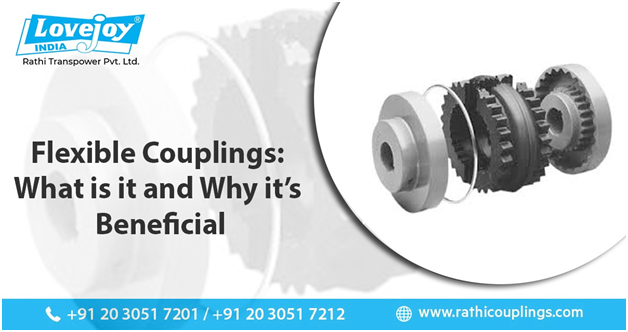32
0
1
Flexible Couplings-Rathi Group
2
1
Flexible couplings are utilized to transmit torque starting with one shaft then onto the next when the two shafts are marginally misaligned.
Flexible couplings can require fluctuating degrees of misalignment up to 3 ° and some parallel misalignment. Likewise, they can also be utilized for vibration damping or noise reduction.
A coupling intended to permit a constrained precise movement between the axis of two waveguides.
Why are flexible couplings?
A flexible coupling exists to transmit control (torque) starting with one shaft then onto the next; to make up for minor measures of misalignment; and, in specific cases, to provide protective functions.
Thus, industrial power transmission regularly calls for adaptable as opposed to rigid couplings.
At the point when the opportunity arises to indicate substitutions for flexible couplings, it's human nature to take a simple way and just discover something comparable, if not identical, to the coupling that failed, possibly applying a couple of larger-than-average fudge components to be moderate.
Too often, however, this training welcomes a repeat disappointment or costly system damage.
The wiser methodology is, to begin with, the assumption that the past coupling failed because in light of the fact that it was the wrong sort for that application.
Taking time to decide the correct kind of coupling is worthwhile even if it confirms the past design.
However, it may lead you to something very surprising that will work better and last more.
Read More: Disc Coupling Manufacturer: Why Rathi Couplings is the Best!
Estimating and choice
The rich variety of accessible flexible couplings gives a wide scope of execution tradeoffs. While choosing among them, oppose the compulsion to exaggerate administration factors.
Coupling administration factors are planned to make up for the variety of torque loads typical of various driven systems and to accommodate sensitive service life of the coupling.
Whenever picked too moderately, they can misguide choice; raise coupling expenses to pointless dimensions, and even welcome damage elsewhere in the system.
Keep in mind that properly chosen couplings more often than not should break before something progressively costly does if the system is over-burdened, inappropriately worked, or some way or another drift out of spec.
Deciding the correct sort of adaptable coupling begins with profiling the application as pursues:
• Prime mover type-electric engine, diesel engine, other
• Real torque requirements of the determined side of the system, as opposed to the rated horsepower of the prime mover - note the scope of variable torque coming about because of cyclical or erratic loading, “assuming the worst possible scenario” startup loading, and the measure of beginning quit switching action basic common during normal operation
• Vibration, both linear and torsional
• Shaft sizes, keyway sizes, and the desired fit among shaft and bore
• Shaft-to-shaft misalignment
• Axial (in / out) shaft movement, distance, and some other space-related limitations.
• Ambient conditions
Visit us: https://rathicouplings.com/blog/flexible-couplings-what-is-it-and-why-its-beneficial/https://rathicouplings.com/
Flexible couplings can require fluctuating degrees of misalignment up to 3 ° and some parallel misalignment. Likewise, they can also be utilized for vibration damping or noise reduction.
A coupling intended to permit a constrained precise movement between the axis of two waveguides.
Why are flexible couplings?
A flexible coupling exists to transmit control (torque) starting with one shaft then onto the next; to make up for minor measures of misalignment; and, in specific cases, to provide protective functions.
Thus, industrial power transmission regularly calls for adaptable as opposed to rigid couplings.
At the point when the opportunity arises to indicate substitutions for flexible couplings, it's human nature to take a simple way and just discover something comparable, if not identical, to the coupling that failed, possibly applying a couple of larger-than-average fudge components to be moderate.
Too often, however, this training welcomes a repeat disappointment or costly system damage.
The wiser methodology is, to begin with, the assumption that the past coupling failed because in light of the fact that it was the wrong sort for that application.
Taking time to decide the correct kind of coupling is worthwhile even if it confirms the past design.
However, it may lead you to something very surprising that will work better and last more.
Read More: Disc Coupling Manufacturer: Why Rathi Couplings is the Best!
Estimating and choice
The rich variety of accessible flexible couplings gives a wide scope of execution tradeoffs. While choosing among them, oppose the compulsion to exaggerate administration factors.
Coupling administration factors are planned to make up for the variety of torque loads typical of various driven systems and to accommodate sensitive service life of the coupling.
Whenever picked too moderately, they can misguide choice; raise coupling expenses to pointless dimensions, and even welcome damage elsewhere in the system.
Keep in mind that properly chosen couplings more often than not should break before something progressively costly does if the system is over-burdened, inappropriately worked, or some way or another drift out of spec.
Deciding the correct sort of adaptable coupling begins with profiling the application as pursues:
• Prime mover type-electric engine, diesel engine, other
• Real torque requirements of the determined side of the system, as opposed to the rated horsepower of the prime mover - note the scope of variable torque coming about because of cyclical or erratic loading, “assuming the worst possible scenario” startup loading, and the measure of beginning quit switching action basic common during normal operation
• Vibration, both linear and torsional
• Shaft sizes, keyway sizes, and the desired fit among shaft and bore
• Shaft-to-shaft misalignment
• Axial (in / out) shaft movement, distance, and some other space-related limitations.
• Ambient conditions
Visit us: https://rathicouplings.com/blog/flexible-couplings-what-is-it-and-why-its-beneficial/https://rathicouplings.com/
